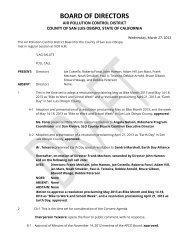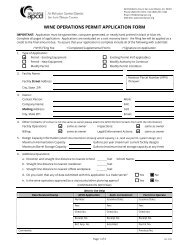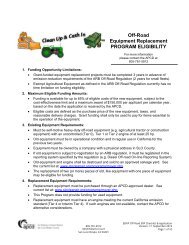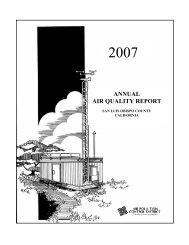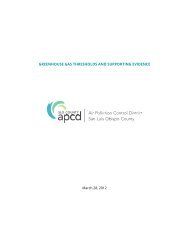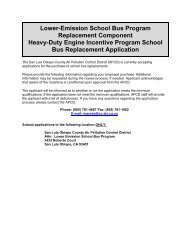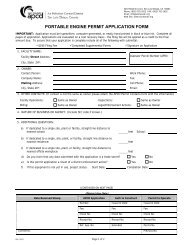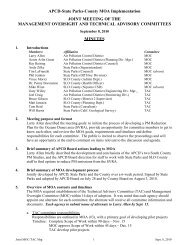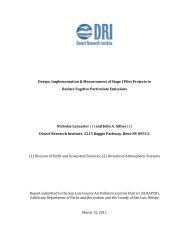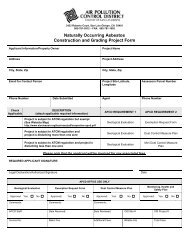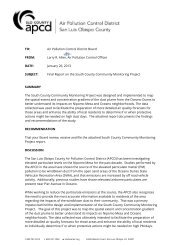CEQA Air Quality Handbook - Air Pollution Control District
CEQA Air Quality Handbook - Air Pollution Control District
CEQA Air Quality Handbook - Air Pollution Control District
Create successful ePaper yourself
Turn your PDF publications into a flip-book with our unique Google optimized e-Paper software.
SLO County APCD <strong>CEQA</strong> <strong>Air</strong> <strong>Quality</strong> <strong>Handbook</strong> 2012<br />
previous emission estimates and finalize mitigation measures. The following variables can be defined for<br />
each piece of construction equipment:<br />
• Equipment type;<br />
• <strong>Quality</strong> of equipment used;<br />
• Horsepower rating;<br />
• Load factor;<br />
• Usage (hours/day);<br />
• Engine model year;<br />
• Engine deterioration (years and hours since last rebuild); and,<br />
• Exhaust after-treatment devices such as VDEC (verified diesel emission control devices).<br />
More detailed information about CalEEMod can be found at www.caleemod.com<br />
2.3 ROG, NO X , PM AND GHG COMBUSTION MITIGATION MEASURES<br />
Construction mitigation measures are designed to reduce emissions (ROG, NO x , DPM, PM 10 and GHG)<br />
from heavy-duty construction equipment and may include emulsified fuels, catalyst and filtration<br />
technologies, engine replacement, new alternative fueled trucks, and implementation of Construction<br />
Activity Management Plans (CAMP). The mitigation measures for construction activity fall into three<br />
separate sections:<br />
• Standard Mitigation Measures<br />
• Best Available <strong>Control</strong> Technologies (BACT) and Construction Activity Management Plans<br />
− Construction Activity Management Plans (CAMP)<br />
− Retrofit Devices and Alternative Fuels<br />
− Repowers<br />
• Fugitive Dust Mitigation Measures<br />
Measure Applicability<br />
Measures should be applied as necessary to reduce construction impacts below the significance thresholds<br />
listed in Table 2-1. Construction equipment mitigation measures and construction activity management<br />
practices have been shown to significantly reduce emissions while maintaining overall equipment<br />
performance and project scheduling needs. Project proponents shall determine daily and quarterly<br />
construction phase impacts and define mitigation that will be implemented if impacts are expected to<br />
exceed the SLO County APCD’s construction phase thresholds of significance.<br />
The following list of standard and specific mitigation measures shall be incorporated into project<br />
conditions depending on the level of impacts. Ozone precursors (ROG + NO x ) are to be combined and<br />
compared to the SLO County APCD’s construction phase significance thresholds. Applying the BACT<br />
for construction equipment or implementing a Construction Activity Management Plan is required when<br />
the Quarterly Tier 2 construction significance thresholds of 6.3 tons per quarter ROG + NO x or 0.32 tons<br />
per quarter diesel PM are exceeded.<br />
2.3.1 Standard Mitigation Measures for Construction Equipment<br />
The standard mitigation measures for reducing nitrogen oxides (NO x ), reactive organic gases (ROG), and<br />
diesel particulate matter (DPM) emissions from construction equipment are listed below:<br />
• Maintain all construction equipment in proper tune according to manufacturer’s specifications;<br />
• Fuel all off-road and portable diesel powered equipment with ARB certified motor vehicle<br />
diesel fuel (non-taxed version suitable for use off-road);<br />
• Use diesel construction equipment meeting ARB's Tier 2 certified engines or cleaner off-road<br />
heavy-duty diesel engines, and comply with the State off-Road Regulation;<br />
2-6



